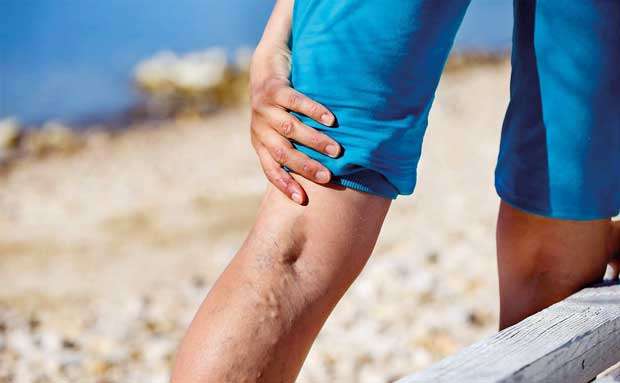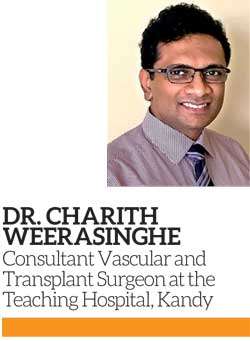24 Aug 2018 - {{hitsCtrl.values.hits}}

 ‘Varicose veins’ is a common condition which mainly presents in middle aged females and if neglected may lead to complications. With the advancement of medical technology LASER treatment is successfully used to cure this condition. To shed light on the topic we spoke to Dr. Charith Weerasinghe Consultant Vascular and Transplant Surgeon attached to the Teaching Hospital, Kandy.
‘Varicose veins’ is a common condition which mainly presents in middle aged females and if neglected may lead to complications. With the advancement of medical technology LASER treatment is successfully used to cure this condition. To shed light on the topic we spoke to Dr. Charith Weerasinghe Consultant Vascular and Transplant Surgeon attached to the Teaching Hospital, Kandy.
What are varicose veins ?
Varicose veins are veins that have become enlarged and twisted. The term commonly refers to the veins on the leg, although varicose veins can occur elsewhere as well. Veins have pairs of leaflet valves to prevent blood from flowing backwards (retrograde flow or venous reflux). Malfunctioning of the valves leads to backflow of venous blood and this leads to various ailments in the leg.
What are the causes ?
Causes of varicose veins can include:
1.Standing or sitting for long periods of time.
2. Family history. If other family members had varicose veins, there’s a greater chance you will too.

3.Deep Vein Thrombosis- formation of clots in the large deep veins of the legs.
4. Pregnancy. Some pregnant women develop varicose veins. Varicose veins that develop during pregnancy generally improve without medical treatment 3 to 12 months after delivery. If they persist you need to be examined by a vascular surgeon.
5.Age. As you get older, your veins can lose elasticity, causing them to stretch.
6. Gender- Women are more likely to develop the condition. Hormonal changes during pregnancy, premenstruation or menopause may be a factor because female hormones tend to relax vein walls. Similarly taking hormone replacement therapy or birth control pills may increase your risk of varicose veins.
7.Obesity. Being overweight increases the risk
What are the symptoms of varicose veins?
Varicose veins may not cause any pain or trouble in most instances. But in some instances you may have the following symptoms and signs.
1. Veins that are dark purple or blue in colour
2. Veins that appear twisted and bulging; often like cords on your legs
3. An achey or heavy feeling in your legs.
4. Burning, throbbing, muscle cramping and swelling in your lower legs.
5. Worsened pain after sitting or standing for a long time.
6. Itching around one or more of your veins.
7. Bleeding from varicose veins.
8. A painful cord in the vein with red discoloration of the skin (Thrombophlebitis).
9. Colour changes, hardening of the vein, inflammation of the skin or skin ulcers near your ankle, which can mean you have a serious form of vascular disease that requires medical attention.
Diagnosing varicose veins
Your doctor will likely examine your legs and visible veins while you’re sitting or standing and then diagnose varicose veins. He / she may ask you about any pain or other symptoms you may have.Your doctor may also want to do an ultrasound scan to check your blood flow. This is a non invasive test that uses high-frequency sound waves. This involves application of gel and visualization of the veins using a probe placed over your leg. It allows your doctor to see how blood is flowing in your veins.
How are varicose veins treated?
In general, initial stage of management is conservative when treating varicose veins. You’ll probably be advised to make changes to your lifestyle, instead of trying more aggressive treatments.
Lifestyle changes- The following changes may help prevent varicose veins from becoming worse:
1. Avoid standing for extended periods of time.
2. Lose weight or maintain a healthy weight
3. Exercise to improve your circulation.
4. Use compression socks or stockings.
5. Elevation of your legs whenever you’re resting or sleeping can alleviate symptoms
Your doctor may also want to do an ultrasound scan to check your blood flow. This is a non invasive test that uses high - frequency sound waves
What are the other treatments available ?
If lifestyle changes aren’t working, or if your varicose veins are causing a lot of pain or damaging your overall health, your doctor might try an invasive procedure.
There are six main grades of varicose veins. Generally the first two grades are conservatively managed and grade 3 onwards treated invasively. Treatment modality has to be ideally decided by a vascular surgeon. These are doctors who have specialised in blood vessel conditions. Treatment method recommended can depend on your symptoms, size, and location of the varicose vein.
There are 4 main treatment options available. These include:
1. Sclerotherapy- By injecting a sclerosant drug in the form of liquid or foam into the vein, the lumina of the veins will be closed (you may be asked to come for repeated sessions of treatment and the success rate is variable ).
2. Surgery - Vein ligation and stripping is a surgical treatment that requires anaesthesia and has a higher success rate.
3. Laser therapy
Laser procedure involves placing a laser fibre inside the affected vein under the guidance of ultrasound scan ( gel and probe). Here Heat energy is used to block off a vein which is varicosed. There will be no old fashioned larger cuts and patients have minimal pain which will respond to simple painkillers.This treatment can be even done with a locally numbing agent without general anaesthesia and has equal success rate as surgery.
Major benefits of this kind of procedure are rapid recovery, minimal in hospital stay and lesser time to start routine activities. Patients are generally discharged on the same day after surgery.Nowadays patients prefer to have laser surgery and this is the most popular and one of the best forms of treatment currently available for varicose veins. It is now practiced as the first line treatment option in advanced vascular centers.
4. Other Endovenous ablation therapy - mechanical and radiofrequency waves are used to block off a vein. This modality is not widely used as laser.
What are the myths about varicose vein treatments ?
There are myths associated with the treatment for this condition. A common one is that these superficial leg veins will be needed for future bypass surgery. However, these distorted veins are not suitable for Coronary Artery Bypass Graft (CABG) surgery. Another myth is some may think that after surgery a particular leg will be shortened. This type of complication is not at all possible with treatment.
One myth that haunts patients is whether laser therapy can lead to cancer later on in life. This has been clearly disproved and laser is used in multiple eye, brain, genito-urinary and skin therapies and there is no basis at all for such fear.
Another common myth is that whatever treatment is done for the varicose veins they will recur. But this is not so if done by a specially trained and experienced surgeon.
One thing we should keep in mind is identifying and treating varicose veins early will prevent many complications. Latest treatment modalities such as laser therapy will minimize surgical complications and leads to rapid recovery. However, these procedures should be done in technologically advanced hospital by an experienced team.
20 Nov 2024 3 minute ago
20 Nov 2024 12 minute ago
20 Nov 2024 12 minute ago
20 Nov 2024 13 minute ago
20 Nov 2024 39 minute ago